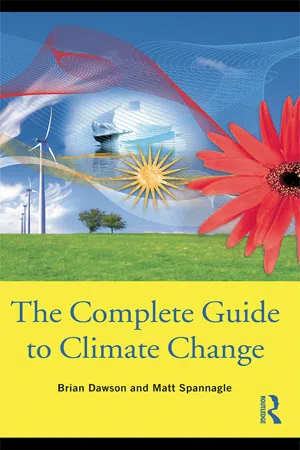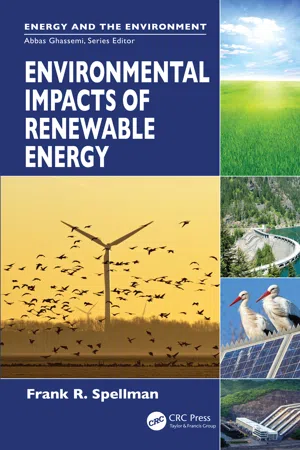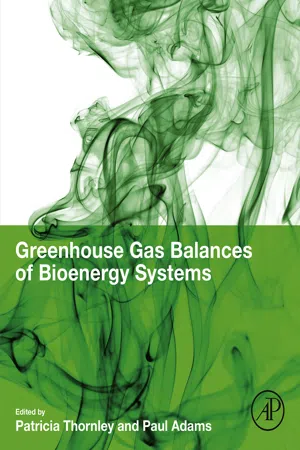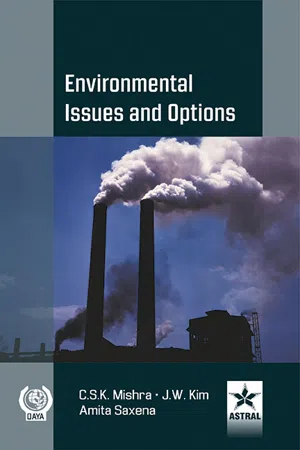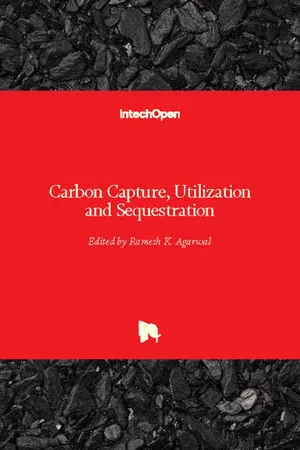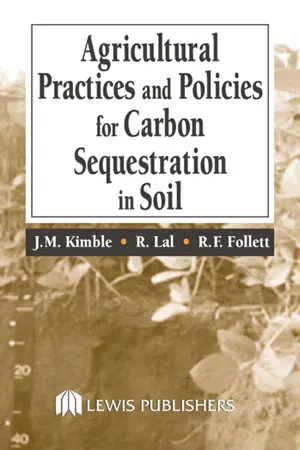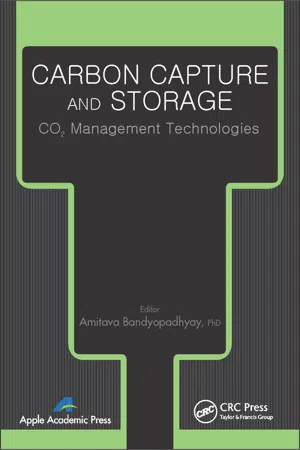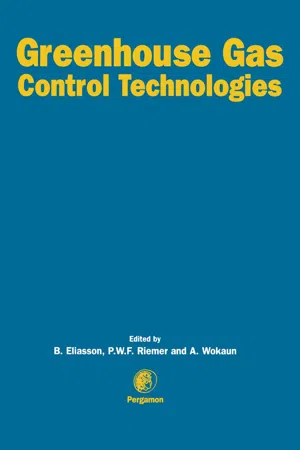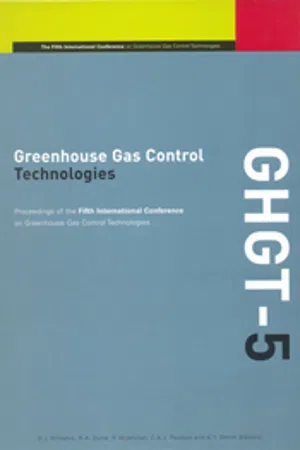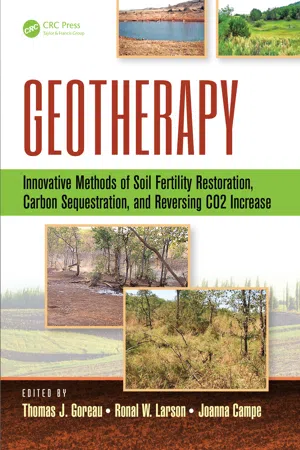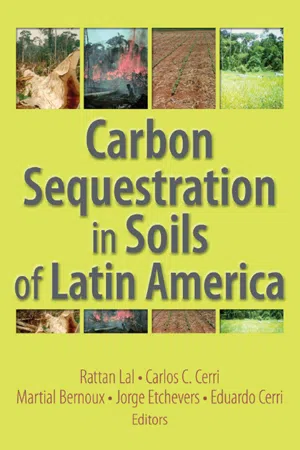Geography
Biological Carbon Sequestration
Biological carbon sequestration refers to the process by which plants, trees, and other living organisms absorb carbon dioxide from the atmosphere and store it in their tissues and in the soil. This natural process helps to mitigate climate change by reducing the amount of carbon dioxide in the atmosphere. Forests, wetlands, and agricultural lands are important ecosystems for biological carbon sequestration.
Written by Perlego with AI-assistance
Related key terms
1 of 5
12 Key excerpts on "Biological Carbon Sequestration"
- eBook - ePub
- Brian Dawson, Matt Spannagle(Authors)
- 2008(Publication Date)
- Routledge(Publisher)
BIOSEQUESTRATIONBiosequestration refers to the process of removing carbon dioxide (CO2) from the atmosphere and storing it in land or ocean reservoirs through biological processes managed, promoted, or facilitated by humans. Biosequestration is one of a wide range ofmitigationoptions available to limit or reduce the buildup of greenhouse gases in the atmosphere.The cycling of carbon between the land and oceans and atmosphere is a fundamental driver of life on earth, and each year large quantities of CO2 are exchanged between these three active carbon reservoirs (seecarbon cycle). By managing or manipulating the flows of carbon between these three reservoirs, either through enhancing the biological processes to sequester carbon from the atmosphere (such as planting trees) or through preventing carbon stored in the land and ocean reservoirs from entering the atmosphere (such as preventing trees from being cut down), humans can influence the amount of CO2 stored in the atmosphere. While humans may be able to influence the biological uptake of CO2 by oceans (e.g. through iron fertilization—seeocean carbon sinks), biosequestration is more commonly used to describe measures that influence the amount of carbon stored by the land system. The remainder of this section deals with measures that influence theland carbon sink.Through the natural processes of the carbon cycle, the land system is currently absorbing more CO2 from the atmosphere each year than it emits back to the atmosphere—it is, therefore, a netcarbon sink. Uncertainty surrounds the magnitude of the land carbon sink effect, but it is estimated to be around 6–8 GtCO2 per year, though the uncertainty range is between 4 and 9 GtCO2 per year (seeland carbon sink). Overall net CO2 uptake by the land is currently helping to slow the buildup ofgreenhouse gasesin the atmosphere. This is providing the global community with some breathing space in which to introduce the full range of emissionmitigation - eBook - PDF
- Frank R. Spellman(Author)
- 2014(Publication Date)
- CRC Press(Publisher)
The term carbon sequestration is used to describe both natural and deliberate processes by which CO 2 is either removed from the atmosphere or diverted from emission sources and stored in the ocean, terrestrial environments (vegetation, soils, and sediments), and geologic formations. Before human-caused CO 2 emissions began to occur, the natural processes that make up the global carbon cycle (see Figure 9.1) maintained a near balance between the uptake of CO 2 and its release back to the atmosphere. However, existing CO 2 uptake mechanisms (sometimes called CO 2 or carbon sinks ) are insufficient to offset the accelerating pace of emissions related to human activities. Annual carbon emissions from burning fossil fuels in the United States are about 1.6 gigatons (billion metric tons), whereas annual uptake amounts are only about 0.5 gigatons, resulting in a net release of about 1.1 gigatons per year (see Figure 9.2). Scientists at the U.S. Geological Survey (USGS) and elsewhere are working to assess both the potential capacities and the potential limitations of the various forms of carbon sequestration and to evaluate their geologic, hydrologic, and ecological consequences. The USGS is providing information needed by decision makers and resource managers to maximize carbon storage while minimizing undesirable impacts on humans and their physical and biological environment. Atmospheric CO 2 Organic C Plants and Animals Decaying and Burning Photosynthesis O 2 H 2 O Respiration H 2 O O 2 FIGURE 9.1 The global carbon cycle. Carbon naturally moves, or cycles, between the atmosphere and vegetation, soils, and the oceans over time scales ranging from years to mil-lennia and longer. Human activities, primarily the burning of fossil fuels and clearing of forests, have increased the transfer of carbon as CO 2 to the atmosphere. - eBook - ePub
- Patricia Thornley, Paul Adams(Authors)
- 2017(Publication Date)
- Academic Press(Publisher)
Chapter 5Biogenic Carbon—Capture and Sequestration
Zoe M. Harris* ; Suzanne Milner† ; Gail Taylor†* Imperial College London, London, United Kingdom† University of Southampton, Southampton, United KingdomAbstract
Biogenic carbon emissions are those that originate from biological sources such as plants, trees, and soil. Biogenic carbon emissions relate to the natural carbon cycle and there is significant interest in quantifying how plants capture CO2 in the process of photosynthesis, how it is lost in respiration and stored in biomass (both living and dead), and finally biologically sequestered into long-term biological stores in the soil. This biogenic terrestrial carbon cycle offers significant potential for greenhouse gas emissions (GHG) reductions and here we summarise findings for the major bioenergy crops, for biogenic carbon fluxes, and stores that contribute to Biological Carbon Sequestration. The quantification of biogenic carbon in recent years has proved to be a highly controversial topic, since this stored carbon is used in national GHG inventories and in estimating whether bioenergy crops are sustainable.Keywords
Biogenic carbon; Carbon capture; Carbon sequestration; Carbon cycle; Biomass; Ecosystem carbon accounting; Carbon debt; BECCS5.1 Biogenic Carbon Capture and Potential for Storage and Sequestration
Plants require three key inputs to grow: water, carbon dioxide, and sunlight. Through the process of photosynthesis, plants are able to convert solar radiation into chemical energy used for the growth of new tissue, a process described by the equation for photosynthesis:Carbon dioxide + water→glucose + oxygenSunlight + chlorophyllThe products of photosynthesis are carbohydrates and oxygen. Oxygen is released into the atmosphere and glucose is used to manufacture new cells within the plant, enabling growth and biomass production. There are two different metabolic photosynthetic pathways that lead to biomass production: C3 and C4. C3 plants tend to originate from temperate regions and fix CO2 directly using Ribulose- 1,5-bisphosphate carboxylase oxygenase (RuBisCO) to produce two 3-carbon molecules, hence ‘C3 plants’ (Fig. 5.1 ). Examples of C3 bioenergy crops include willow, poplar, and Arundo . C3 plants use the Calvin cycle, but are relatively inefficient since RuBisCO can also react with O2 in a process called photorespiration. Carbon-concentrating mechanisms have evolved in plants to make them more efficient and C4 photosynthesis is one such carbon-concentrating mechanism. In C4 plants, CO2 is initially fixed by an enzyme with a much higher affinity for CO2 (phosphoenolpyruvate (PEP) carboxylase) with no oxygenase activity. RuBisCO is spatially isolated in specialist cells and CO2 is re-fixed in these bundle sheath cells (Fig. 5.1 ). The photosynthetic process in C4 plants is more efficient than in C3 plants, and several food crops are C4 such as maize and sorghum. They can cope with hot and dry environments since they have high water use efficiency (WUE). C4 bioenergy crops include Miscanthus - eBook - PDF
- Mishra, C S K(Authors)
- 2021(Publication Date)
- Daya Publishing House(Publisher)
Figure 1.1 Carbon Sequestration Technology is Needed to Reduce GHG Emissions This ebook is exclusively for this university only. Cannot be resold/distributed. Figure 1.2 Changes in Atmospheric CO 2 Concentration Carbon Sequestration in Terrestrial Ecosystems The terrestrial carbon sequestration is the natural solution to stored massive amounts of carbon. Carbon sequestration in terrestrial ecosystems can be defined as the net removal of CO 2 from the atmosphere into long-lived pools of carbon. The pools can be living, above ground biomass ( e.g ., trees), products with a long, useful life created from biomass ( e.g., lumber), living biomass in soils ( e.g., roots and microorganisms), or recalcitrant organic and inorganic carbon in soils and deeper subsurface environments. It is important to emphasize that increasing photosynthetic carbon fixation alone is not enough. This carbon must be fixed into long-lived pools. Otherwise, one may be simply altering the size of fluxes in the carbon cycle, but not increasing carbon sequestration. Capture and Storage of Carbon Terrestrial Ecosystems Terrestrial ecosystems that include both soil and vegetation are widely recognized as a major biological “scrubber” for CO 2 . Terrestrial sequestration is defined as either the net removal of CO 2 from the atmosphere or the prevention of CO 2 emissions from leaving terrestrial ecosystems. Sequestration can be enhanced in four ways: reversing land use patterns; increasing the photosynthetic carbon fixation of trees and other vegetation; and creating energy offsets using biomass for fuels and other products. The terrestrial biosphere is estimated to sequester large amounts of carbon, about 2 billion tons (2 Gt) of carbon annually. The total amount of carbon stored in This ebook is exclusively for this university only. Cannot be resold/distributed. soils and vegetation throughout the world is estimated to be about 2,000 Gt +/– 500. - Ramesh K. Agarwal(Author)
- 2018(Publication Date)
- IntechOpen(Publisher)
The higher the NPP the more carbon is transferred to stable pools in the soils [17]. 4. Carbon sequestration Carbon sequestration is the process of transferring carbon dioxide (CO 2 ) from the atmosphere into stable terrestrial carbon (C) pools. The process can be driven naturally or anthropogenically. The anthropogenically driven sequestration ensures that there is no net gain in the atmospheric C pool because the CO 2 sequestered comes from the atmosphere. There are basically two types of sequestration: abiotic and biotic. The abiotic techniques involve injection of CO 2 into deep oceans, geologi-cal strata, old coal mines and oil wells. The biotic component on the other hand, involves managing higher plants and micro-organisms to remove more CO 2 from the atmosphere and fixing this C instable soil pools. Biotic sequestration is further subdivided into oceanic and ter -restrial sequestration. Oceanic sequestration involves C capture by photosynthetic activities of organisms such as phytoplankton, which converts the C into particulate organic material and deposits such on the ocean floor. This type of sequestration is reported to fix about 45 Pg C/year [18]. Terrestrial sequestration involves the transfer of CO 2 from the atmosphere into the biotic and pedologic C pools. This is accomplished by the transfer or sequestration of CO 2 through pho-tosynthesis and storage in live and dead organic matter. The major terrestrial C sinks include: forests, soils and wetlands. 4.1. Carbon sequestration in soil ecosystem Soil carbon sequestration is defined by Olson et al. [ 19] as: the process of transferring carbon dioxide from the atmosphere into the soil of a land unit through plants, plant residues, and other organic solids, which are stored or retained in the unit as part of the soil organic matter (humus) [19] . Carbon Capture, Utilization and Sequestration 6- John M. Kimble, Rattan Lal, Ronald F. Follett(Authors)
- 2016(Publication Date)
- CRC Press(Publisher)
28 AGRICULTURE PRACTICES AND POLICIES FOR CARBON SEQUESTRATION IN SOIL biotic options is converting atmospheric CO 2 into biomass and transforming a fraction (10 to 20%) into the SOC pool. There is a wide array of biotic processes ranging from molecular or microbial reactions to those occurring in the rhizosphere, on clay surfaces leading to formation of organo–min-eral complexes, within the profile involving humification and leaching of dissolved organic carbon (DOC), and over the soil and landscape involving production of biomass. Three abiotic processes exist, two of which involve compression of CO 2 emitted by industrial complexes and injection into geologic strata and deep ocean. The third is a soil process that involves dissolution of atmospheric CO 2 leading to formation of carbonates following reaction with Ca +2 or Mg +2 cations brought in from outside the ecosystem. Leaching of carbonates into ground water is an important mechanism of C sequestration (Nordt et al., 2000). Over and above leaching, annual sequestration of C in soil carbonates and caliches can be 10 to 11 Tg C/yr (Schlesinger, 1997). A report prepared by DOE (Battelle, 2000) concluded that, among all options, SOC sequestration is the most cost-effective strategy available within the next 25 to 50 years. Further, it is a win–win strategy because of numerous ancillary benefits (Lal et al., 1998). CONCLUSIONS The historic loss of SOC pool due to conversion from natural to agricultural ecosystems and subsequent soil cultivation by plowing and excessive tillage has contributed a large amount of anthropogenic emissions of CO 2 to the atmosphere. In addition to enhancing the risks of accelerated greenhouse effect and reducing quality of natural waters, depletion of the SOC pool has adversely affected soil quality. Soils with depleted SOC pools have low biomass productivity, especially in farming systems with low external input.- eBook - PDF
Carbon Capture and Storage
CO2 Management Technologies
- Amitava Bandyopadhyay(Author)
- 2014(Publication Date)
- Apple Academic Press(Publisher)
PART II GEOLOGICAL SEQUESTRATION OF CO 2 This chapter was originally published under the Creative Commons Attribution License. Wielopol-ski L. Geological Carbon Sequestration: A New Approach for Near-Surface Assurance Monitoring. International Journal of Environmental Research and Public Health 2011, 8 (2011). doi:10.3390/ ijerph8030818. GEOLOGICAL CARBON SEQUESTRATION: A NEW APPROACH FOR NEAR-SURFACE ASSURANCE MONITORING LUCIAN WIELOPOLSKI CHAPTER 4 4.1 INTRODUCTION Global warming and climate change are attributed to increases in the con-centration of greenhouse gases (GHG) in the atmosphere, from anthropo-genic emissions of CO 2 , from the pre-industrial revolution level of about 260 ppm, to present day concentrations of about 391 ppm, viz., ~35% in-crease [1]. The main sources of GHG emissions are associated with burn-ing fossil fuels, changing land usage, and cultivation of the soil. To combat global climate change will require a combination of approaches including improving energy efficiency and using alternative energy sources. Pre-dictions of the increased use of energy globally during this century and continued reliance on fossil fuels point to a further rise in GHG emissions [2] with a concomitant one in atmospheric CO 2 concentrations. These con-sequences cannot be abated unless major changes are made in the way energy is produced and used; in particular, how carbon is managed [3,4]. Mitigating the forecast increase in fossil-fuel consumption includes pro- 106 Carbon Capture and Storage: CO 2 Management Technologies ducing clean fuels, capturing industrially generated CO 2 , and sequester-ing this CO 2 in deep geologic formations (carbon capture & sequestration (CCS)). The attractiveness of the CCS program stimulated significant in-vestments by governments and the private sector to develop the necessary technologies, and to evaluate whether CO 2 control could be implemented safely and effectively to maintain the CO 2 in reservoirs. - eBook - PDF
- B. Eliasson, P. Riemer, A. Wokaun(Authors)
- 1999(Publication Date)
- Elsevier Science(Publisher)
In this paper, the IGCC-type of scheme is used as an example of this type of process. Forestry sequestration Growing trees absorb CO2from the atmosphere; as a result, carbon is included in wood, in other biomass and in the soil. Forestry sequestration schemes may involve planting trees in new forests or adding trees to existing forests, or prevention of the clearance of existing forests. In the long term the trees will die and decompose, releasing CO2 to the atmosphere but this will be offset by growth of new trees in their place. In many places, particularly tropical regions, large areas of the remaining natural forests are being cleared. Most of the carbon contained in the biomass in these forests will be converted to CO2 in the short-term. Schemes to prevent clearance of existing forests can be just as effective at avoiding increasing atmospheric CO2 as planting new trees, even though no new carbon is sequestered. In some forestry sequestration schemes, wood will be harvested sustainably to provide income to support the maintenance costs of the forest. It will also provide employment for local communities, to help ensure their commitment to retaining the forest. Carbon contained in harvested wood is normally not considered when calculating the greenhouse gas benefits of sequestration forests. Wood used in long life products, for example buildings and furniture may continue to sequester carbon for a long time but wood from subsidised sequestration forests may simply displace wood grown in other commercial forests. Conversely, the availability of low price wood from subsidised sequestration forests may make it less attractive to fell existing native forests. An alternative use for wood harvested from sequestration forests is to displace fossil fuels in heat and power generation. - eBook - ePub
Greenhouse Gas Control Technologies
Proceedings of the 5th International Conference on Greenhouse Gas Control Technologies
- CAJ Paulson, DJ Williams, RA Durie, P McMullan, AY Smith(Authors)
- 2001(Publication Date)
- CSIRO PUBLISHING(Publisher)
A major challenge in mitigating anthropogenic effects on climate change is the reduction of greenhouse gas emissions into the atmosphere. To this end, no single category of mitigation measures is sufficient, and many of them are mutually dependent and include both reducing greenhouse gas emissions and enhancing greenhouse gas sinks (Turkenburg, 1997). The overall potential and effect of increased CO 2 utilization are negligible, while some mitigation strategies will have a limited impact without major technological breakthroughs and expenditures (Turkenburg, 1997). Thus, to meet mid- to long-term CO 2 -reduction targets agreed on in the Kyoto Protocol, more costly mitigation approaches need to be considered, foremost among them being CO 2 capture and sequestration. Biomass fixation of CO 2 is an option for the mid-term reduction of CO 2 emissions, but, beside some cost issues, factors of practicality and uncertainty make this an improbable solution as yet that has to compete with agriculture, fishing, various industries and land use (Herzog et al., 1997). The oceans represent possibly the largest potential sink, but ocean disposal involves issues of poorly understood physical and chemical processes, sequestration efficiency, cost, technical feasibility and environmental impact (Herzog et al., 1997). In addition, ocean circulation and processes may bring to the fore legal, political and international limitations to large-scale ocean disposal of CO 2. This leaves CO 2 sequestration in geological media as the best option currently available for the long-term sequestration of CO 2. Fossil fuels and power generation are intrinsically and serendipitously linked with sedimentary basins (Hitchon et al., 1999), consequently lowering overall transportation costs. The technology for the underground storage of oil and gas, and of deep injection of CO 2 and industrial liquid waste is well developed and practiced - eBook - PDF
Pandora's Toolbox
The Hopes and Hazards of Climate Intervention
- Wake Smith(Author)
- 2022(Publication Date)
- Cambridge University Press(Publisher)
We’ll grow the trees and then burn them, so through the cycle, this is theoretically carbon neutral (in practice, there is generally lots of leakage that makes this far less than carbon neutral). On the one hand, that’s better than digging carbon out of geological reservoirs (i.e., fossil fuels) and burn- ing it, thereby adding to the stock of carbon in the active exchange, but bioenergy doesn’t draw down those stocks. BECCS on the other hand does. After the biomass is combusted, the smoke wafting up the flue is scrubbed of its carbon, which is then purified and transported to a disposal site. It is thereafter pumped down underground into suitable mineral formations where it will remain safely sequestered indefinitely – permanently from a human perspective. The problem with BECCS and all of its forestation-related cousins is the land requirements. As we saw in Chapter 10, trying to set aside enough forested land to merely offset our current levels of emissions would over a few generations consume most of the arable land on the planet – obviously both an expensive and untenable situation on a planet that may top out with 10+ billion humans. BECCS solves part of that problem by harvesting the forest as soon as it is mature, such that the designated land can be replanted and thereby reused to suck down a new load of carbon. Still, the land required is massive. Nonetheless, if we further consider BECCS, we realize that it entails two capture processes rather than just one. The majestic trees ingest the carbon from the air, but that carbon is released in the com- bustion process and turned right back into the CO 2 gas we are trying to get rid of. That got us nowhere. The carbon must then be recaptured as it tries to make its way up the smokestack and back to the atmosphere. Only after the second capture do we have a substance that we can manipulate, transport, and sequester underground. - eBook - PDF
Geotherapy
Innovative Methods of Soil Fertility Restoration, Carbon Sequestration, and Reversing CO2 Increase
- Thomas J. Goreau, Ronal W. Larson, Joanna Campe, Thomas J. Goreau, Ronal W. Larson, Joanna Campe(Authors)
- 2014(Publication Date)
- CRC Press(Publisher)
This suggests a lifetime of elemental carbon charcoal in soils of at least 400 million years and indicates that elemental carbon has a lifetime that is infinite for all our practical carbon storage needs and far longer than any other form of carbon. How Much CO 2 Can We Store: Carbon Sequestration Capacity Many different soil and biomass sinks are capable of storing enough carbon by themselves, and in com- bination, to absorb all the excess CO 2 above safe levels, and stabilize climate change. The first and most obvious is biomass. Massive and accelerating increase of CO 2 from fossil fuel com- bustion over the last 150 years, since the industrial revolution, caused the famous so-called hockey stick curve of temperature increase (Mann et al., 2008), which has been fully confirmed in all of its details as it has been greatly extended in length (Marcott et al., 2013). However, a major part of the excess atmospheric CO 2 to date comes from the much slower destruction of the great forests of Asia, Europe, and North America since the start of agriculture 10,000 years ago, with South America, Africa, and Southeast Asia coming to the fore only after the forest vanished in northern temperate zones and from erosion and decomposition of soil carbon following deforestation (Bohn, 1978; Houghton, 2003; Lal, 2004; Ruddiman, 2005; Perlin, 2005; Lal, 2011). The amount of forest left is constantly decreasing, while the fossil fuel output is rising exponentially, so land degradation is now a minor and diminishing global source of atmospheric CO 2 . It has been obvious to anyone who looks at forests and deforested areas that if the latter could be reforested, vast amounts of carbon could be stored, and if the forests were to be fully restored, most of the existing excess could be absorbed. If the fertility of the soil were to be restored or further enhanced by using rock powders and biochar, then we propose that all of the excess could be taken up, the core point of this entire book. - Rattan Lal, Carlos Cerri(Authors)
- 2006(Publication Date)
- CRC Press(Publisher)
This is not compatible with the con-cept of arriving at a new steady state of SOC stocks due to a management change, which will just as easily be reversed if the management change is re-versed or altered. However, if restored pastures become degraded, reforested hillsides are again deforested, or NT operations are abandoned in favor of CT, this “sequestered” C will again be released. Policymakers should be made aware of this, so that higher productivity systems with minimal soil distur-bance, once installed, must be maintained if higher SOC stocks are to be sus-tained. Furthermore, once a new steady state of SOC has been attained, no further mitigation of CO 2 emissions is possible on that land. From the point of view of mitigating CO 2 emissions by agricultural ac-tivities, a surer method is the use of biofuels. In this case each Mg of biofuel C produced will leave in the geological strata a certain proportion of that Mg of C (depending on the energy balance). This substitution is a real and permanent gain. REFERENCES Alves, B.J.R., R.M. Boddey, and S. Urquiaga. (2003). The success of BNF in soy-bean in Brazil. Plant and Soil 252:1-9. Alves, B. J. R., L. Zotarelli, R. M. Boddey, and S. Urquiaga. 2002. Soybean benefit to a subsequent wheat cropping system under zero tillage. In Nuclear techniques in integrated plant nutrient, water and soil management . IAEA, Vienna, pp. 87-93. 342 CARBON SEQUESTRATION IN SOILS OF LATIN AMERICA Amado, T.J.C., C. Bayer, F.L.F. Eltz, and A.C. Brum. (2001). Potencial de culturas de cobertura em acumular carbono e nitrogênio no solo no plantio direto e a melhoria da qualidade ambiental. Revista Brasileira da Ciência do Solo 25:189-197 (in Portuguese). Anonymous (1998). Lavoura Orgânica. Manchete Rural (Rio de Janeiro) 11:37-38 (in Portuguese). Armstrong, A.P., J. Baro, J. Dartoy, A.P. Groves, J. Nikkonen, and D.J. Rickeard. (2002). Energy and greenhouse gas balance of biofuels for Europe—an update .
Index pages curate the most relevant extracts from our library of academic textbooks. They’ve been created using an in-house natural language model (NLM), each adding context and meaning to key research topics.
